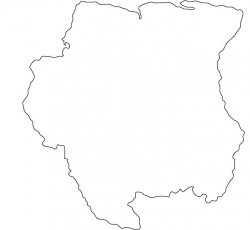
أجهزة الملاحة العربية
Your way to more knowledge
Product successfully added to your shopping cart
Quantity
Total
There are 0 items in your cart.
There is 1 item in your cart.
Total products
Total shipping
To be determined
Total
- Countries of the World
- Zip code in Jordan
- List of surahs in the Holy Qur'an
- All flags of the countries of the world
- Traffic signs in Jordan
- Population of world countries by country
- List of world capitals
- Car Brand Logos and Names
- International Calling Codes
- List of currencies of the world
- Country flags of the world with images and names
- Country codes names
- List of countries and dependencies by area
- Al-Quran Recitations mp3
- List of countries and dependencies by population
- World time zones by country
Suriname
Official name: Republic of Suriname
Also known as: Dutch Guiana, Netherlands Guiana, Republiek Suriname (Dutch)
Capital of Suriname: Paramaribo
Area of Suriname: 163,820 km² (63,251 mi²) (91th)
Population of Suriname: 634,431 (171th) - (2024 est.)
Location: Northern South America, bordering the North Atlantic Ocean, between French Guiana and Guyana.
Languages of Suriname: Dutch (official), English (widely spoken), Sranang Tongo (Surinamese, sometimes called Taki-Taki, is native language of Creoles and much of the younger population and is lingua franca among others), Hindustani (a dialect of Hindi), Javanese.
Religions of Suriname: Christian 48.4% (Protestant 26.75, Roman Catholic 21.65%), Hinduism 22.3% (Sanātanī 17.97%, Arya Samaj 3.08%, Other Hindu1.23%), Muslim 13.9% (Sunni 3.91%, Ahmadiyya 2.61%, Other Muslim 7.34%), Winti 1.8%, Kejawèn 0.8%, Judaism 0.03%, no religion 7.52%, Not stated 2.04%, Don't know 1.11%, Others 0.85% (2012 est.)
Calling code: (+597)
Organizations: United Nations, Caribbean Community
Border countries (3): Brazil 597 km, French Guiana 510 km, Guyana 600 km
Coastline: 386 km (240 mi).
Administrative divisions: 10 districts (distrikten, sing. – district):
Brokopondo, Commewijne, Coronie, Marowijne, Nickerie, Para, Paramaribo, Saramacca, Sipaliwini, Wanica.
Natural resources: Timber, hydropower, fish, forests, hydroelectric potential, kaolin, shrimp, bauxite and gold. Small amounts of nickel, copper, platinum and iron ore. It also has sizeable oil.
Area of Suriname: 163,820 km² (63,251 mi²) (91th)
Population of Suriname: 634,431 (171th) - (2024 est.)
Location: Northern South America, bordering the North Atlantic Ocean, between French Guiana and Guyana.
Languages of Suriname: Dutch (official), English (widely spoken), Sranang Tongo (Surinamese, sometimes called Taki-Taki, is native language of Creoles and much of the younger population and is lingua franca among others), Hindustani (a dialect of Hindi), Javanese.
Religions of Suriname: Christian 48.4% (Protestant 26.75, Roman Catholic 21.65%), Hinduism 22.3% (Sanātanī 17.97%, Arya Samaj 3.08%, Other Hindu1.23%), Muslim 13.9% (Sunni 3.91%, Ahmadiyya 2.61%, Other Muslim 7.34%), Winti 1.8%, Kejawèn 0.8%, Judaism 0.03%, no religion 7.52%, Not stated 2.04%, Don't know 1.11%, Others 0.85% (2012 est.)
Ethnic groups in Suriname: Hindustani (also known locally as "East Indians"; their ancestors emigrated from northern India in the latter part of the 19th century) 27.4%, Maroon (their African ancestors were brought to the country in the 17th and 18th centuries as slaves and escaped to the interior) 21.7%, Creole (mixed White and Black) 15.7%, Javanese 13.7%, Mixed 13.4%, other 7.6%, unspecified 0.6% (2012 est.)
Currency: Surinamese dollar (SRD)Calling code: (+597)
Organizations: United Nations, Caribbean Community
Border countries (3): Brazil 597 km, French Guiana 510 km, Guyana 600 km
Coastline: 386 km (240 mi).
Administrative divisions: 10 districts (distrikten, sing. – district):
Brokopondo, Commewijne, Coronie, Marowijne, Nickerie, Para, Paramaribo, Saramacca, Sipaliwini, Wanica.
Natural resources: Timber, hydropower, fish, forests, hydroelectric potential, kaolin, shrimp, bauxite and gold. Small amounts of nickel, copper, platinum and iron ore. It also has sizeable oil.

